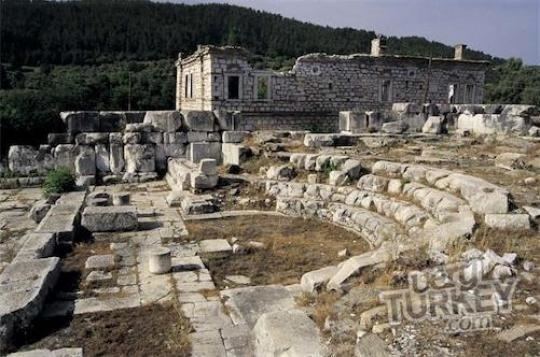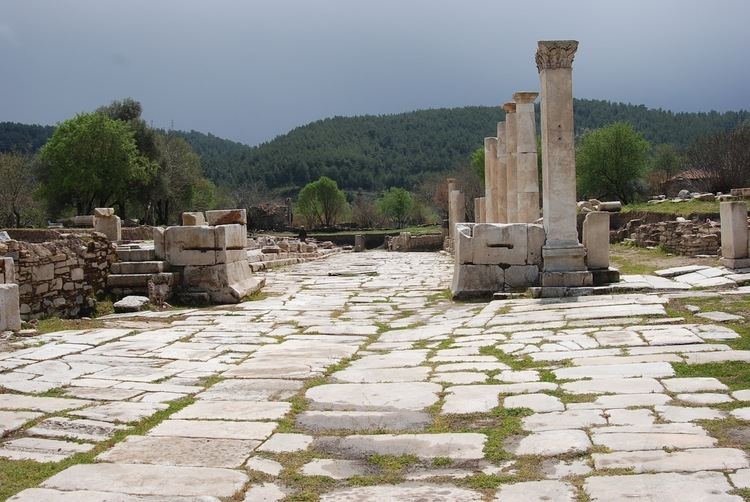Type Settlement | ||
 | ||
Alternate name Stratonikeia, Stratoniceia, Stratoniki, Stratonike, Stratonice, Idrias, Chrysaoris, Hadrianopolis Location Eskihisar, Muğla Province, Turkey | ||
Stratonicea (Greek: Στρατoνικεια or Στρατoνικη; or per Stephanus of Byzantium: Στρατονίκεια) – also transliterated as Stratonikeia, Stratoniceia , Stratoniki, and Stratonike and Stratonice; earlier Idrias and Chrysaoris; and for a time Hadrianopolis – was one of the most important towns in the interior of Caria, Anatolia, situated on the east-southeast of Mylasa, and on the south of the river Marsyas; its site is now located at the present village of Eskihisar, Muğla Province, Turkey. It is situated at a distance of 1 km (0.62 mi) from the intercity road that connects the district center of Yatağan with Bodrum and Milas, shortly before Yatağan Power Plant if one has taken departure from the latter towns.
Contents

Foundation and Seleucid era
According to Strabo, it was founded by the Seleucid king Antiochus I Soter (281–261 BC), who named it after his wife Stratonice. Or at least this is what has been generally told; some historians have contested this date as too early, and proposed to consider the city's founder Stratonice's son, Antiochus II Theos, or, later still, Antiochus III the Great.

What seems certain is that the city was founded on the site of an old Carian town, Idrias, anciently called Chrysaoris, said to be the first town funded by the Lycians. Later it passed under the control of the Achaemenid Empire. According to Athens' tribute "assessment" of 425 BC Idrias was supposed to be responsible for the payment of the considerable sum of six talents. Like many other non-Greek cities on the 425 BC assessment Idrias is never recorded actually paying any tribute to Athens and was never a member of the Delian League. In early Seleucid times, Stratonikeia was a member of the Chrysaorian League, a confederation of Carian towns. The Stratonikeians, though not of Carian origin, were admitted into the confederacy, because they possessed certain small towns or villages, which formed part of it. The league is attested by an inscription already in 267 BC, but was probably older still. Near the town was the temple of Zeus Chrysaoreus, at which the League's assembly met; at these meetings several city-states had votes in proportion to the number of towns they possessed.
Under the succeeding Seleucid kings, Stratonikeia was adorned with splendid and costly buildings. At a later time in the 3rd century BC it was ceded to the Rhodians. Rhodes seems to have then temporarily lost it, possibly during king Philip V of Macedon's Carian campaign (201–198 BC), but it retook control of the place in 197 BC, keeping it until 167 BC when the whole of Caria was declared free by the Roman Republic. From this point starts the city's independent coinage, which was to last until the times of the emperor Gallienus (253–268). In 130 BC the city had a central role in the revolt led against the Romans, since here the self-proclaimed king Aristonicus made a last stand before falling in the hands of his enemies with the fall of the city.
Roman era

Some time after, in 88 BC, Mithridates VI of Pontus (120–63 BC), after imposing a fine and a garrison on the city, resided for some time at Stratonikeia, and married Monime, the daughter of Philopoemen, one of its principal citizens. Then came in 40 BC the siege sustained against Quintus Labienus and his Parthian troops, and the brave resistance it offered to him entitled it to the gratitude of Augustus and the Senate. The emperor Hadrian is said to have taken this town under his special protection, and to have changed its name into Hadrianopolis, a name, however, which may (also) refer to another town also called Stratonikeia. Pliny enumerates it among free cities in Anatolia. Menippus, according to Cicero one of the most distinguished orators of his time, was a native of Stratonikeia.
Under the Roman Empire, the town seems to have continued in its prosperity: it was in this age that were built Stratonikeia's most impressive remains, first of all the theatre, with the seats remaining, estimated to be able to contain no fewer than ten thousand people; and secondly, the Serapeum, or a temple dedicated to the cult of Serapis, built about 200 CE, full of inscriptions and invocations to the gods. Other important ruins are on the acropolis, surrounded by a wall and crowned by a small temple dedicated to the cult of the emperors, and a powerful fortress. Much worse is the state of conservation of the city walls and its agora, while the location of the temple of Zeus Chrysaoreus is still unknown.
Episcopal see
Stratonicea was Christianized early. The Notitiae Episcopatuum mention the see up to the 13th century among the suffragans of Stauropolis. Only three of its bishops are known, by their signatures at councils:
The ancient bishopric of Stratonicea in Caria is included in the Catholic Church's list of titular sees. No further titular bishop of this eastern see has been appointed since the Second Vatican Council.
Today
The city's site is today partly occupied by the Turkish village of Eskihisar, and part of the site's necropolis (allegedly of modest scientific significance) has vanished with the opening of a pit to extract the lignite reserves that feed the nearby Yatağan power plant. The pit is proposed to be transformed into a lake in the coming years, once the reserves there are exhausted. The village has a local museum, which contains mostly Roman remains; but the most remarkable object is a Mycenaean stirrup-cup of buff with horizontal red stripes which is dated to the 12th or 11th century BC. All the exhibits were found locally.
